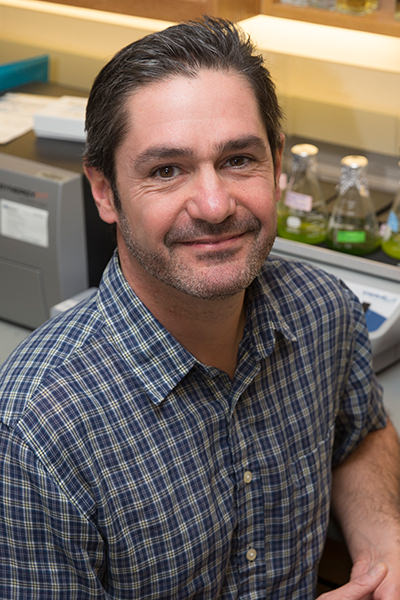Hans Wildschutte
Hans Wildschutte
Ph.D., University of Pittsburgh
Office: 424B Life Sciences Building
Phone: 1-419-372-4704
Email: hansw@bgsu.edu
Research:
Environmental microbiology, drug discovery, phage therapy

Research Interests:
By the year 2050, infections from multi-drug resistant (MDR) pathogens is predicted to surpass cancer and be the leading cause of death around the world. Research in the Wildschutte lab is focused on characterizing environmental bacteria and phage that inhibit MDR pathogens. Using a unique population-level strategy involving phylogenetic structure and function analysis, we identify natural isolates that inhibit the growth of devastating MDR pathogens. Our work involves an interdisciplinary approach that utilizes field research, wet-bench experimentation, whole genome analyses, and bioinformatics to identify novel antibiotic compounds and broad host-range phage. Results are exploited to translate basic research forward to clinical practice for antibiotic treatment and phage therapy.
Selected Publications:
Basalla J, Chatterjee P, Burgess E, Khan M, Verbrugge E, Wiegmann DD, LiPuma J, and Wildschutte H. Loci identified that encode potentially active compounds against drug resistant pathogens amidst a decreasing pool of novel antibiotics. Appl Environ Microbiol. Nov 2019; 85(23):1-17. doi: 10.1128/AEM.01438-19
Wagner A, Norris S, Chatterjee P, Morris P, and Wildschutte H. Aquatic pseudomonads inhibit oomycete plant pathogens of Glycine max. Frontiers Microbiol, May 2018; 29:9:1007. doi.org/10.3389/fmicb.2018.01007
Davis E, Sloan T, Tripathi A, Aurelius K, Barbour A, Bodey E, Clark B, Dennis C, Drown R, Fleming M, Humbert A, Kerns T, Lingro K, McMillin M, Meyer A, Pope B, Stalevicz A, Steffen B, Steindl A, Williams C, Wimberley C, Zenas R, Butela K, and Wildschutte H. Antibiotic discovery though The Small World Initiative: a molecular strategy to identify biosynthetic gene clusters involved in antagonistic activity. MicrobiologyOpen. Jan 2017; 00:1-9. doi: 10.1002/mbo3.435
Impact Publications:
Burks D, Norris S, Joy A, Kauffman K, Arevalo P, Azad R, and Wildschutte H. Environmental vibrios represent a source of antagonistic compounds that inhibit pathogenic Vibrio cholerae and Vibrio parahaemolyticus strains. MicrobiologyOpen. Oct 2017; 6e504:1-11.
D’souza NA, Kawarasaki Y, Lee RE, Gantz JD, Beall BFN, Shtarkman YM, Koçer ZA, Rogers SO, Wildschutte H,Bullerjahn GS, McKay RML. Microbes promote ice formation in large lakes. ISME 2013.
Cordero OX, Wildschutte H, Kirkup B, Proehl S, Hussain F, Ngo L, Le Roux F, Mincer T, and Polz MF. Natural antibiotic production and resistance reveals social structure of wild bacterioplankton populations. Science 2012; 337:1228-1231.
Updated: 01/07/2025 04:42PM


